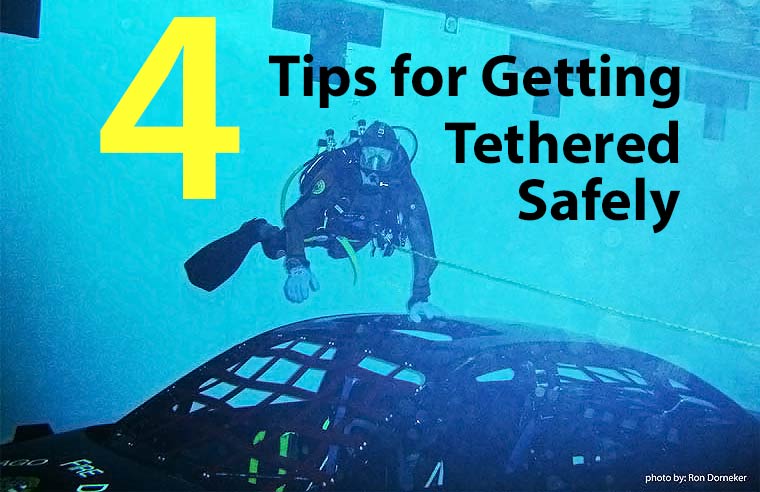Interview with Deputy District Chief for Chicago Fire Department, Ron Dorneker
by Ron Dorneker and Sean Harrison
ERDI – Chief Dorneker, first off, thank you for taking the time to sit down with Emergency Response Diving International (ERDI) and discuss what we think is a very important topic. There are varying opinions on whether divers should be tethered or not but for the purposes of this article we are going to discuss it from the point of view that all divers are tethered.
Before we get into the time tested tips you have to offer, let’s give the readers a little background on you, and your team, so they have a better understanding of the size and typical number of responses and environments your team dives in.
Chief Dorneker – I have been in charge of the Chicago Fire Department Marine & Dive Operations since 2001. There are approximately 140 Chicago Fire Department personnel currently working as Public Safety Divers. This includes divers assigned on our Helicopters, FastBoat 688, SCUBA Team 687 and Squad Companies 1, 2, 5 and 7. These divers act as first responders to immediate life threats due to drowning anywhere within the open waters of Lake Michigan, Lake Calumet, Wolf Lake, the Chicago River, the Calumet River, the Shipping and Sanitary Canal as well as lagoons and ponds around the city. A mutual aid is also given to surrounding inland lakes and the Lake Michigan waterfront of surrounding suburbs. Diving conditions can include black water, polluted waters, extreme cold and ice conditions, and during severe weather and night time operations.
Last year the Chicago Fire Department responded to 249 water rescue incidents. Those incidents included drowning, persons having general trouble in the water, persons missing in the water, jumpers from bridges, persons in or on the ice, vehicles in the water, boat sinkings, boat fires, stranded boat, boat accidents, animals in the water or in/on the ice, victim recovery operations, roadway floods, and rescues of people from their homes during residential flooding.
Also last year, the Chicago Fire Department Divers logged over 3200 hours of training for those types of incidents.
Tip 1
ERDI – Thank you for that very insightful behind the scenes view of your team. Very impressive! Let’s get to the topic at hand and see if we can break this down into critical components. Having watched you work with your team over the years, I know you keep a pretty close eye on things and constantly analyze if operations are working or how they could work better. Staying on the cutting edge of safety. What is the first thing your teams does when it comes to tethering?
Chief Dorneker – Our divers wear a chest harness over their dry suits and under the BCD. The attachment point on the harness is a D-Ring located at the center of the chest. We fasten a carabineer to our tether lines and attach that to the D-Ring. Once the diver is connected to that tether line, the tender must hold that line in his hand until the diver is dressed down and the line is disconnected.
Tip 2
ERDI – What kind of checks or inspections does your team perform?
Chief Dorneker – Tether lines are inspected each day by the oncoming team of divers as part of their daily inventory. The team also inspects the lines before each dive, and again after the dive when being put back in service. This inspection is overseen by the Dive Supervisor.
Harnesses are inspected by the individual diver each day before being put in service. The harness is checked again during a tender check of the diver before we begin the dive. This inspection is also overseen by the Dive Supervisor.
Tip 3
ERDI – What is the reasoning behind tethering your divers?
Chief Dorneker – We tether our divers for two reasons, safety and search effectiveness.
As far as safety goes, Chicago Fire Department divers are always tethered and use full face mask communications during all dive operations. This allows the team to know the exact location of the diver in the water. During any diver distress, our contingency training and plan uses that tether line as a means to descend directly to the distressed diver. Descending on that line saves time. Time is always our enemy when it comes to water rescue operations.
With regard to effectiveness, after identifying the last seen point and determining the area to search, we direct our diver to search an exact area. We call that area “the box.” The tender uses landmarks to keep the diver in the box and conduct a thorough search. We know how long each leg of the search will be, and how many legs of the search the diver will swim to search the entire box. Having the diver on a tether and being tender-directed allows us to factor in visibility to maximize our efforts. We know from the diver what the visibility is during the search. This allows the tender to modify the patterns so the diver does not have to swim to the edge of the box. The tender can stop the diver short on each leg of the box based on visibility. This saves time, has the diver swimming less distance and results in a quicker search of the area.
Tip 4
ERDI – Any other thoughts on tethered divers?
Chief Dorneker – Solo divers being tendered, directed during search and rescue operations, require training on both the part of the diver and tender. It is not easy for someone not used to diving with tether lines to master that skill. It is also not easy to communicate simple thoughts from a tender to a diver. Standardized patterns and standardized communications helped our team achieve success with solo divers being tendered, directed to locate victims and also helped keep our team safer.


發表評論
想加入討論?隨時歡迎參與討論!